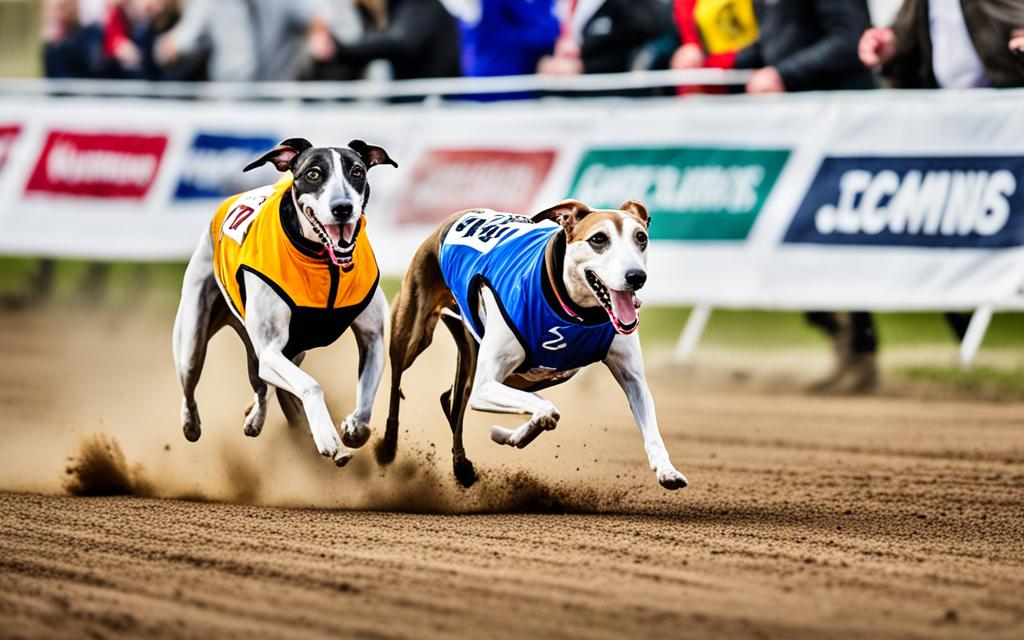
Is Dog Racing Ethical, Did you know that the global dog racing industry has faced increasing scrutiny due to its ethical concerns and controversies surrounding animal welfare? From mistreatment to moral implications, the sport of dog racing has sparked heated debates and raised questions about the ethical treatment of racing dogs. In this article, we will delve into the history of dog racing, examine the abuses faced by racing dogs, and discuss the moral implications of this widely practiced sport.
Key Takeaways:
- Dog racing has raised ethical concerns regarding the treatment and welfare of racing dogs.
- Abuses experienced by racing dogs have ignited controversies surrounding the sport.
- The history and development of dog racing will be explored in this article.
- Arguments against dog racing will be examined, focusing on the ethical considerations involved.
- Understanding the moral implications of dog racing is crucial for advocating for change and improving animal welfare.
- The State of Dog Racing Globally
- The Killings and Overbreeding of Greyhounds
- Cruelty and Injuries in Dog Racing
- Drug Use and Doping in Dog Racing
- Greyhound Racing in Countries with Poor Welfare Standards
- Financial Health and Decline of Dog Racing
- Shifting Public Opinion and Advocacy Efforts
- Ineffectiveness of Anti-Cruelty Statutes
- Advocating for an End to Dog Racing
- Conclusion: Is dog racing Ethical
The State of Dog Racing Globally
Despite its historical popularity, the global dog racing industry is currently facing a significant decline. This decline can be attributed to successful investigations and campaigns led by animal welfare groups, which have shed light on the ethical concerns and controversies surrounding dog racing.
As a result of these efforts, there has been a decrease in attendance and the closure of many dog racing tracks around the world. However, the industry is not without resilience and is working towards adaptation and survival.
Greyhound racing, one of the most prominent forms of dog racing, remains legal only in seven countries: the UK, Ireland, New Zealand, Australia, the US, Vietnam, and Mexico. While these countries have implemented animal welfare laws, instances of abuse still persist.
Investigations have uncovered illegal activities within the industry, including the use of live bait and the administration of illegal drugs to training greyhounds. These revelations demonstrate the need for greater enforcement and stricter regulations to ensure the well-being and fair treatment of racing dogs.
| Country | Legality of Greyhound Racing | Animal Welfare Laws |
|---|---|---|
| United Kingdom | Legal | Yes |
| Ireland | Legal | Yes |
| New Zealand | Legal | Yes |
| Australia | Legal | Yes |
| United States | Legal | Varies by state |
| Vietnam | Legal | No |
| Mexico | Legal | Varies by state |
Note: The table above provides an overview of the legality of greyhound racing and the presence of animal welfare laws in countries where it is still permitted.
The Killings and Overbreeding of Greyhounds
In countries like Ireland and the US, the mass killing of greyhounds is a disturbing reality that highlights the plight of these magnificent animals. Oversupply in the greyhound market has led to a tragic cycle of overbreeding, resulting in many unnecessary deaths and contributing to the issue of animal homelessness.
In Ireland, approximately 6,000 greyhounds are killed each year due to the oversupply in the market. This staggering number would be even higher if unregistered deaths were included. The demand for racing dogs has created a significant oversupply, causing many greyhounds to be deemed surplus to requirements and ultimately disposed of.
In the US, over 6,000 greyhounds are bred for racing each year, further exacerbating the problem. With a surplus of dogs, there is an insufficient demand to accommodate them all, leading to the unnecessary loss of lives. These greyhounds, bred for the sole purpose of racing, often face dismal conditions and are subjected to the ultimate betrayal of being discarded once their racing careers end.
The mass killing of greyhounds not only removes the lives of these sentient beings but also diverts resources away from addressing the pressing issue of animal homelessness. Animal shelters and rescue organizations are stretched thin, trying to rehouse and provide for the countless greyhounds left abandoned and in need of care.
“Greyhounds are consistently bred only for profit, leading to oversupply and an unjustifiable loss of lives. It is a heartbreaking consequence of an industry that places little value on the wellbeing of these incredible animals.”
The mass killing and overbreeding of greyhounds is a dark reality that cannot be ignored. The ethical implications and needless deaths demand urgent action to address the underlying causes and protect these gentle creatures from further harm.
| Countries | Greyhound Deaths per Year |
|---|---|
| Ireland | Approximately 6,000 |
| United States | Over 6,000 |
Cruelty and Injuries in Dog Racing
Racing dogs, including greyhounds, endure immense suffering throughout their racing careers. These majestic animals are subjected to wire cage confinement for the majority of their days, enduring cramped and unclean conditions that are detrimental to their physical and psychological well-being.
The perils of dog racing extend beyond the confines of their wire cages. During races, these dogs face a high risk of painful injuries and even death. In Ireland, between 2015 and 2018, over 1,500 greyhound injuries were documented. Shockingly, an average of 120 deaths are reported each year in connection with the sport. The situation in the United States is similarly distressing, with reports of greyhounds being starved and denied necessary veterinary care.
Greyhound injuries and deaths in the racing industry are heartbreaking reminders of the extreme risks these animals face. Their physical well-being is compromised by the relentless pursuit of profit at the expense of their health and quality of life.
Quote:
“The suffering and injuries endured by racing dogs are an undeniable reality that cannot be ignored. It is our responsibility to put an end to this cruelty and treat these animals with the compassion they deserve.” – Animal Rights Advocate
These statistics shed light on the devastating consequences of dog racing, emphasizing the urgent need for reform within the industry. It is imperative that society addresses the ethical concerns surrounding the suffering and mistreatment of racing dogs, advocating for their well-being and ensuring that their lives are not sacrificed for human entertainment.
| Country | Documented Greyhound Injuries (2015-2018) | Average Annual Greyhound Deaths |
|---|---|---|
| Ireland | 1,500+ | 120+ |
| United States | N/A | N/A |
Note: The United States lacks comprehensive data on greyhound injuries and deaths in the racing industry, highlighting the need for increased transparency and accountability.
Drug Use and Doping in Dog Racing
Drug use is an unfortunate reality in the dog racing industry, with devastating effects on the well-being of racing dogs. Investigations have revealed the widespread use of illegal drugs to enhance the performance of greyhounds, including cocaine and steroids. These substances are administered with the aim of improving speed, endurance, and overall racing capabilities, giving a competitive advantage to the dogs involved.
“The use of drugs in dog racing is a clear example of unethical behavior within the industry. It not only compromises the fairness of the sport but also poses serious health risks to the animals.”
Over the period of 2007-2019, a staggering 847 documented cases of drug-positive racing greyhounds were reported in the United States alone. These figures highlight the disturbing prevalence of drug use within the industry, calling into question the integrity of dog racing as a legitimate sport.
Illegal drugs such as cocaine and steroids can have significant negative impacts on the physical and psychological health of racing dogs. Cocaine, for example, is a powerful stimulant that can lead to increased heart rate, elevated blood pressure, and potential cardiac complications. Steroids, on the other hand, can cause a range of adverse effects, including liver damage, aggression, and reproductive issues.
Furthermore, these drugs can disrupt the natural heat cycle of female greyhounds, allowing for more racing days and increased profit for owners. However, this exploitation of the dogs’ reproductive cycles adds another layer of unethical behavior to an already problematic industry.
Documented Cases of Drug Use in Dog Racing:
| Year | Number of Drug-Positive Racing Greyhounds |
|---|---|
| 2007 | 32 |
| 2008 | 76 |
| 2009 | 45 |
| 2010 | 52 |
| 2011 | 89 |
| 2012 | 98 |
| 2013 | 126 |
| 2014 | 73 |
| 2015 | 91 |
| 2016 | 104 |
| 2017 | 82 |
| 2018 | 71 |
| 2019 | 83 |
These numbers demonstrate the alarming frequency at which drug use occurs in dog racing, further emphasizing the urgent need for stricter regulations and enforcement to eradicate these unethical practices.
Greyhound Racing in Countries with Poor Welfare Standards
In countries without proper animal welfare laws, greyhounds suffer even more. These countries lack the necessary regulations and protections to ensure the well-being of racing dogs. Unfortunately, greyhounds from countries like Ireland, Australia, and the US often end up in countries with poor welfare standards, such as Pakistan.
In Pakistan, greyhounds are used in coursing events, a cruel practice that involves chasing and capturing live prey. This puts immense physical and mental strain on the dogs, leading to horrific injuries and even death. The absence of welfare laws means that greyhounds in Pakistan are subjected to these brutal events without any regard for their safety or well-being.
Furthermore, greyhounds from countries with insufficient welfare laws may also be sold for meat in countries like Pakistan. These dogs are often viewed purely as commodities, with their lives disregarded for profit. The conditions in which these greyhounds are kept and transported are typically deplorable, causing further suffering and distress.
Quotes:
“The lack of welfare laws in these countries allows for the exploitation and mistreatment of greyhounds,” says Jane Davis, animal rights activist. “It’s disheartening to see these dogs endure such cruelty in the pursuit of profit.”
The international trade of greyhounds to countries with poor welfare standards highlights the urgent need for stronger global regulations and protections for racing dogs. Advocacy efforts must focus on raising awareness about the plight of these animals and exerting pressure on governments to enact and enforce comprehensive animal welfare laws.
Through collaborative efforts and international cooperation, we can strive towards ending the suffering of racing greyhounds and ensuring that they are treated with the compassion and dignity they deserve.
Financial Health and Decline of Dog Racing
The dog racing industry has been facing significant financial strain and decline, with the decline of dog racing revenue contributing to its overall decline. This has been a global trend affecting many countries, including the United States.
In the US, state racing revenue has experienced a staggering decline of 82% between 2001 and 2014. This decline has put immense financial pressure on the industry, making it increasingly difficult for dog racing tracks to sustain their operations and remain profitable.
The financial health of the industry is heavily reliant on funding from government departments. Without this support, many dog racing tracks would struggle to survive. The declining revenue has also led to the closure of numerous tracks, further impacting the industry’s viability.
The Economic Impact of Dog Racing
The decline of the dog racing industry has not only affected the revenue and financial health of the industry itself, but it has also had broader economic implications.
“The closure of dog racing tracks and the decline in revenue have resulted in job losses for individuals employed in the industry, contributing to local economic downturns.”
Communities that heavily relied on the dog racing industry are now grappling with the economic consequences of its decline. This includes the loss of employment opportunities and a decrease in tourism and related businesses that once thrived due to dog racing events.
However, it’s worth noting that there are still regions where the dog racing industry has experienced relatively stable or even increased revenue, primarily due to betting activities. While the overall industry faces decline, localized success stories highlight the potential for different approaches and strategies to mitigate financial strain.
Racing Revenue Comparison:
| Country | Declining Racing Revenue |
|---|---|
| United States | 82% decline between 2001 and 2014 |
| United Kingdom | 42% decline between 2009 and 2017 |
| Australia | 30% decline between 2007 and 2019 |
Shifting Public Opinion and Advocacy Efforts
Public opinion on dog racing is undergoing a significant shift, as society becomes increasingly aware of the cruelty and mistreatment endured by racing dogs. Advocacy groups are working tirelessly to raise public awareness and advocate for the end of this industry.
Recent polls have demonstrated a growing support for shutting down dog racing, reflecting the changing attitudes towards the sport. Additionally, state laws have been passed in many areas to ban dog racing entirely, reinforcing the strong public sentiment against this practice.
Advocacy efforts play a crucial role in raising awareness about the ethical concerns of dog racing. Grassroots campaigns, including boycotts and education initiatives, are instrumental in mobilizing individuals and communities to take a stand against the mistreatment of racing dogs.
“We cannot turn a blind eye to the suffering of these innocent animals. It’s our duty to speak up and demand an end to this cruel industry.” – Sarah Thompson, Animal Rights Activist
Raising awareness is key to changing public opinion and driving meaningful change. Through educational initiatives, the public can gain insights into the inhumane practices involved in dog racing and the impact it has on the well-being of racing dogs.
The Power of Grassroots Campaigns
Grassroots campaigns empower individuals to actively contribute to the advocacy against dog racing. These efforts provide a platform for concerned citizens to voice their opinions, organize protests, and engage with local communities to spread awareness.
By leveraging social media platforms, grassroots campaigns can reach a wide audience and generate momentum for change. Sharing personal stories, statistics, and educational resources can inspire empathy and encourage more people to join the movement against dog racing.
Supporting Advocacy Groups
Advocacy groups are at the forefront of the fight against dog racing. These organizations dedicate their time, resources, and expertise to raise awareness, influence public opinion, and push for legislative changes.
Supporting advocacy groups can take various forms, from making donations to participating in fundraising events or volunteering time to assist in their initiatives. Together, we can amplify the voices advocating for the ethical treatment of racing dogs and work towards ending this inhumane practice.
Ineffectiveness of Anti-Cruelty Statutes
While anti-cruelty statutes exist to protect animals from abuse, their limitations become apparent when it comes to safeguarding greyhounds in the dog racing industry. Despite the documented mistreatment and suffering of racing dogs, prosecutions under these statutes are rare, and the penalties imposed are often minimal. This institutionalized abuse and mistreatment of greyhounds often goes unpunished, highlighting the urgent need for stronger measures to effectively protect these animals.
Greyhounds in the racing industry are subjected to cruel practices such as wire cage confinement, inadequate living conditions, and exposure to the risk of serious injuries or even death during races. However, the existing anti-cruelty statutes fail to adequately address these issues and hold accountable those responsible for the welfare of these dogs.
“The existing anti-cruelty statutes fail to adequately address the mistreatment and institutionalized abuse of greyhounds in the dog racing industry.”
Due to the limited prosecutions and minimal penalties, the dog racing industry continues to operate with impunity, perpetuating the cycle of cruelty and exploitation. The absence of strong legal protections allows for the perpetuation of these abusive practices, undermining the well-being of greyhounds.
A comprehensive reform of anti-cruelty statutes is imperative to mitigate the institutionalized abuse of greyhounds. Strengthened legislation should include stricter penalties for offenders, increased oversight of the racing industry, and mandatory enforcement of humane treatment standards.
Only through an overhaul of existing laws can we effectively address the systemic mistreatment of greyhounds and ensure their protection from the ills of the dog racing industry. It is crucial to recognize that the welfare and humane treatment of animals should always be prioritized over profit-driven endeavors.
Limitations of Anti-Cruelty Statutes in Protecting Greyhounds
| Limitations | Examples |
|---|---|
| Lack of specificity | The statutes may not explicitly address the unique mistreatment and risks faced by greyhounds in the racing industry. |
| Inadequate penalties | Penalties imposed for violations of anti-cruelty statutes may be lenient, failing to deter individuals and entities from engaging in abusive practices. |
| Enforcement challenges | Difficulties in enforcing existing laws due to limited resources, lack of awareness, and complexities in investigating and prosecuting cases. |
| Legal loopholes | Greyhound racing industry participants may exploit legal loopholes, allowing them to circumvent anti-cruelty statutes and continue their mistreatment of animals. |
Advocating for an End to Dog Racing
Advocating against dog racing and working towards abolishing greyhound racing is crucial for protecting the welfare of racing dogs. One effective approach is through a voter-initiative-and-education campaign that raises awareness about the abuses experienced by greyhounds and highlights the societal costs associated with this industry. By informing the public about the cruelty involved in dog racing and its negative impact, such a campaign can garner support for legislative action.
Grassroots efforts play a vital role in the movement to end dog racing. Individuals can actively participate by boycotting races and spreading information about the inherent cruelty of the industry. This grassroots activism helps to disrupt the demand for dog racing and draws attention to the urgent need for change. By working together, advocates can amplify their voices and create meaningful impact.
Advocacy organizations dedicated to ending dog racing utilize various strategies to bring about change. They engage in education initiatives to inform the public, collaborate with lawmakers to enact legislation banning dog racing, and support rescue efforts to rehabilitate and provide second chances for retired racing greyhounds. Through these combined efforts, advocates strive to create a future where greyhounds are no longer subjected to the harms of dog racing.
Join us in advocating for the abolition of dog racing. Together, we can ensure a safer and more compassionate world for racing dogs.
Voter-Initiative-and-Education Campaign
A voter-initiative-and-education campaign is a powerful tool for advocating against dog racing. This campaign aims to educate the public about the suffering endured by racing dogs, including the physical and emotional abuses they face. By raising awareness of the inherent cruelty in dog racing, this campaign seeks to mobilize support for legislative measures that will abolish the industry.
The campaign utilizes various strategies, such as:
- Organizing public forums and town hall meetings to facilitate open discussions about the ethical concerns surrounding dog racing.
- Running targeted educational campaigns through media channels, including television, radio, social media, and online platforms, to reach a wider audience.
- Collaborating with animal welfare organizations, community leaders, and influencers to amplify the campaign’s message and engage a broader range of supporters.
By focusing on educating the public about the realities of dog racing, this campaign aims to inspire individuals to take action and advocate for the abolition of this unethical industry.
Grassroots Efforts and Boycotts
Grassroots efforts play a crucial role in advocating against dog racing. Individuals can actively participate by engaging in boycotts and spreading awareness about the cruelty inflicted upon racing dogs. By organizing protests, sharing educational materials, and using social media platforms to amplify their message, grassroots activists can bring attention to the plight of greyhounds and mobilize public support for the cause.
Boycotting races is another impactful way to contribute to the movement. By refusing to attend dog races and withdrawing financial support, individuals can send a powerful message to the racing industry. This grassroots action disrupts the demand for dog racing and puts pressure on legislators to enact change. Additionally, boycotting races draws media attention, which further exposes the inherent cruelty of the industry to a wider audience.
Working Together for Change
Advocating for an end to dog racing requires collaboration among individuals, organizations, and legislators. By working together, advocates can combine their expertise and resources to create meaningful change. From raising public awareness to lobbying for legislation, collective efforts offer a powerful path towards abolishing greyhound racing and ensuring a better future for racing dogs.
Conclusion: Is dog racing Ethical
Dog racing is a morally contentious industry that raises significant ethical concerns. The mistreatment and suffering that racing dogs endure cannot be denied, and as a result, public opinion is shifting towards the recognition that dog racing is not aligned with our moral values. It is imperative that we continue to advocate for the end of this industry, raising awareness about the cruelty involved and pushing for stronger animal welfare protections.
The moral considerations of dog racing are paramount. Greyhounds, like all animals, deserve to be treated with compassion and dignity. The practices of confining dogs in wire cages, subjecting them to injuries and even deaths, and using illegal drugs to enhance their performance are all clear violations of ethical standards.
To bring an end to dog racing, it is crucial that we collectively work towards fostering a society that values the well-being of animals. By supporting grassroots efforts, boycotting races, and participating in educational campaigns, we can contribute to the endeavor of abolishing dog racing and creating a world where animals are protected from suffering and exploitation.











